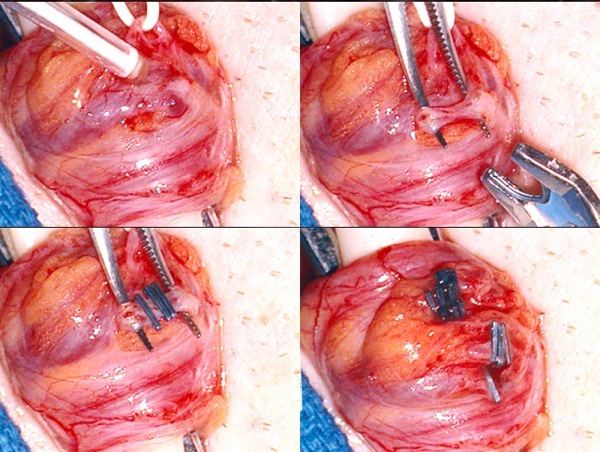Mr. Smith asked me to explain the different methods of treating varicose veins in the scrotum known as a varicocele. There are a few:
- A surgeon makes a small incision in the groin, and ties or clips the veins. The surgeon may use an operating microscope or wear glasses with magnifying lenses to preserve small arteries supplying blood to the testis.
- A surgeon uses a telescope called a laparoscope to find the veins inside the abdomen and tie or clip them.
- A radiologist threads a small tube through the veins and injects material to plug them.
Most surgeons who specialize in male fertility prefer to use an operating microscope or wear glasses with magnifying lenses to perform the procedure, but excellent results can be obtained with either laparoscopy or radiology. A man should ask his doctor about his or her experience, what he or she prefers and why.
This series of pictures shows what the procedure looks like under the operating microscope. The surgeon uses a small probe to listen to the veins as they sound different than arteries. In this procedure, titanium clips were used to block the veins, but surgical suture can also be used.

Thanks, Mr. Smith, for asking a great question!
The testes must be kept cool for the proper production of sperm. One way the human body achieves this is to house them outside the body. Another is to have a network of veins surrounding the artery pumping blood into the testis: the veins take the heat away in a “counter-current” heat exchange similar to a radiator. (The human body is an amazing piece of engineering.)
Arteries don’t need to worry about moving blood; there’s a huge amount of pressure coming from the heart to help with that. But once the blood goes through the capillaries and into the veins, getting back to the heart isn’t easy. Veins have little valves to help hold the blood while it pulses its way back. If those little valves start to separate, the vein expands, causing the condition known as a “varicose vein.” Varicose veins can happen in many places in the body, often visibly in the skin of the legs, but, believe it or not, also in the scrotum. And if varicose veins develop in the scrotum, they can disturb the counter-current heat exchange. The testes then get hot, posing a problem for developing sperm cells.
Varicose veins in the scrotum are called a “varicocele,” and there are three kinds. A grade I varicocele can’t be felt or seen without equipment like ultrasound. Almost all experts now consider grade I varicoceles to be unimportant. Varicoceles that can be felt (grade II) or visible by the naked eye (grade III) are the ones that may cause problems with sperm production. Some men have such high sperm production that their varicoceles don’t significantly alter their chance of making women pregnant. But many men’s testes are affected by grade II or III varicoceles.
Inside of a man, the left vein draining the testis back towards the heart is longer than the right. As a result, varicoceles are most often found in the left scrotum. Sometimes, they’re on both sides, and infrequently, they’re on the right side alone. A right sided varicocele that suddenly appears in adult life is worrisome, as it may be a sign of kidney cancer.
What can be done about a varicocele that may be throwing a wrench into the sperm factory? A urologist can tie or clip the veins in a procedure called “varicocelectomy,” or an interventional radiologist can inject material into the veins to block the flow of blood.

